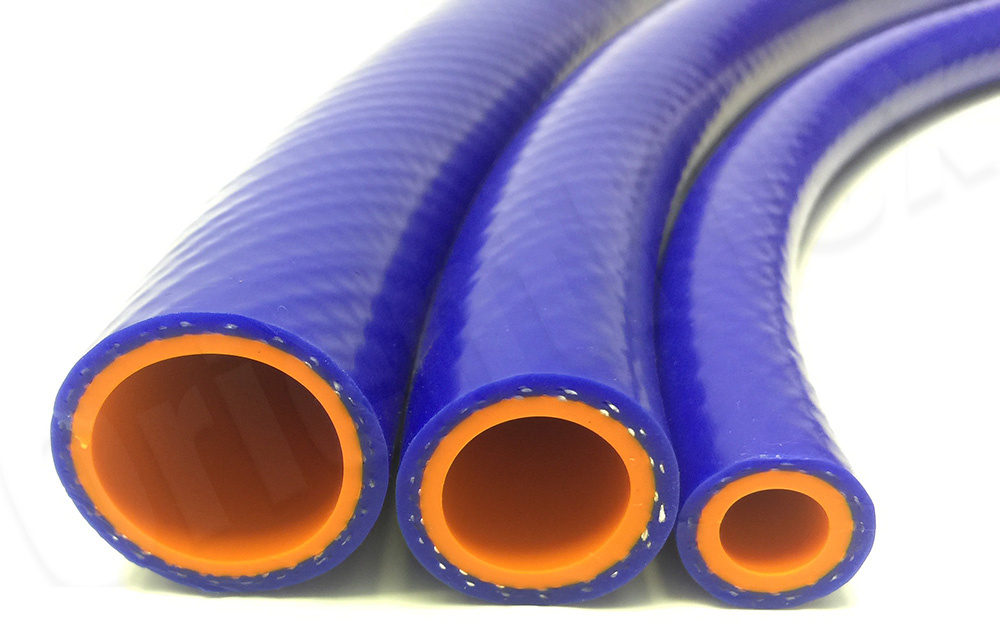Silicone and rubber operation temperature
Due to the severe working temperature of a heater hose, the heater hose is required to be with an excellent heat resistance. From the perspective of heat resistant performance, silicone hoses can deliver gas and liquids in a higher temperature than rubber. We can compare EPDM and silicone withstood working temperature. By the way, EPDM is superior in heat resistant in synthetic rubber material. The silicone hoses can withstand 220 ℃ highest working temperature, whereas the EPDM heater hoses can withstand up to 110 ℃. More than a hundred working temperature difference, this is why the silicone hoses are widely used in vehicle engines’ turbocharger. While the engines generate power, the working temperature will be risen. Silicone hose can be fit for this heat, which made the silicone hoses become ideal choices for diesel-powered car engines. We can provide semi-handmade OEM silicone hoses, including silicone straight meter hoses, silicone straight couplers, silicone elbow hoses, silicone reducer hoses, silicone hump hoses, T shape silicone hoses, silicone corrugated hoses, etc. for being used in cars. What we have talked seemed goes to far. In this piece, we want to compare between silicone and rubber heater hoses’ performance.
Heater Hose applied in HVAC systems
Heater hoses are commonly used in heating, ventilation, and air conditioning (HVAC) systems, or you might apply heater hoses in totally different using applications. Silicone is a good choice for the HVAC systems’ requirements, which still associates with the silicone hoses’ withstood working temperature. Our silicone heater hose SAE J20 R3 can coolant solustions, heat, aging, ozone, cracking, and so forth. We only use 100% quality silicone raw material with quality test. Averagely 4.5mm or 5mm wall thickness requirement and two layer of polyester or aramid reinforcement can withstand working pressure requirement (0.3-1.2 MPa). Good tensile strength. The I.D. sizes ranged from 8mm to 32mm. Then you might ask what about silicone hoses’ other characteristics. Don’t worry, we will compare the strengths and weaknesses of silicone and rubber in each aspect, including flexibility, weather resistance, vibration control, serve life, etc. Don’t worry, we will not hide any silicone and rubber’s weaknesses. You can view and judge by yourself.

Comparison between silicone and rubber
Silicone has a better flexibility and resilience compared to rubber, thus silicone hoses might be unlikely to split or harden. Furthermore, in weather resistant aspect, silicone is also a winner. Silicone almost will not adversely affected by the harsh weather conditions such as rain, snow, UV and ozone. But rubber would deteriorate in such harsh weather factors. With regard to the vibration control, silicone performs good on dampening vibration. However rubber might cause noise due to the friction of rubber. In addition, because silicone is an inert material which unlikely reacts with other materials. Thus, it seems will not cause the adhesion. Another outstanding strength of silicone hoses is its lifespan. While silicone hoses are using in vehicles, the silicone hoses can even last a longer serve life than the cars. From aesthetics perspective, silicone looks great with bling elements.
All of these strengths of silicone hoses sound great, whereas in which aspects the silicone hoses are weak to be applied? The obvious weakness of silicone hoses is the molecular structure of silicone is not good at oil, fuel, and other types of petroleum-based products resistance. We, Orientflex, are able to provide fluorosilicone, which can be oil and oil mist resistant in a certain degree but which is more expensive. The second weakness of silicone hoses is the requirement of specialized hose clamps. It might rise the cost. The third point is that silicone hoses have a relatively poorer sealing ability than rubber. The poorer sealing between the silicone hoses and radiator might negatively influence the system energy and radiators’ efficiency. Choosing the proper hoses is also related to your potential application scenario and size requirement. Our EPDM rubber heater hose SAE J20 R3 size is from 10mm to 25mm. We can offer ISO/TS 16949:2009 registered certification. If you have any concerns and silicone or rubber hose demands, welcome to contact us.